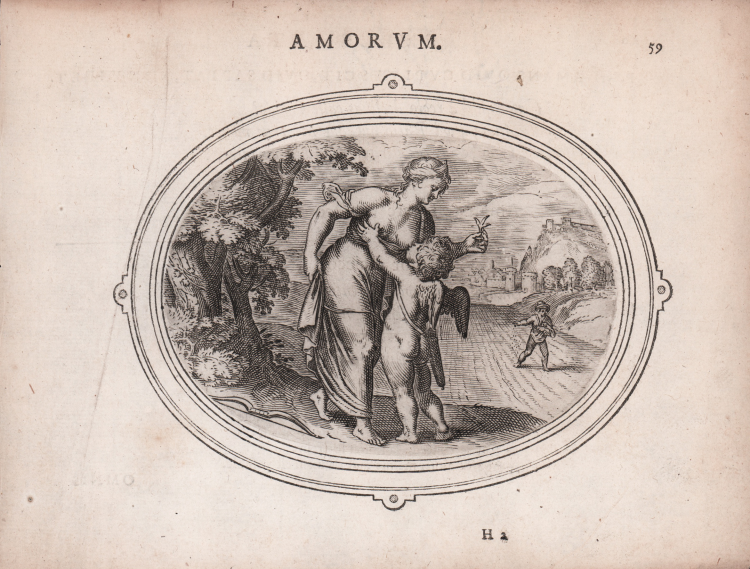




| Reference: | S48480 |
| Author | Cornelis Boel |
| Year: | 1608 |
| Measures: | 200 x 155 mm |



| Reference: | S48480 |
| Author | Cornelis Boel |
| Year: | 1608 |
| Measures: | 200 x 155 mm |
Etching, 1608, after Otto van Veen (Venius). Plate taken form the Amorum emblemata, figuris aeneis incisa studio Othonis Vaeni Batavo-Lugdunensis.
A fine impression, printed on contemporary laid paper, very good condition.
The Amorum Emblemata is considered to be one of the most important and influential of all emblem books. The collection was designed by Otto van Veen (1556-1629) and first published in Antwerp in 1608 in three polyglot versions: Latin, French & Dutch; Latin, Italian & French; and Latin, English & Italian. Its success and popularity lead to many further editions and adaptations, while its images were subsequently used by decorative artists throughout Europe.
In producing a book of love emblems, Van Veen was following a trend which began in Amsterdam in 1601 with the publication of Quaeris quid sit Amor, a compilation of twenty-four love emblem prints produced by the artist Jacques de Gheyn with accompanying Dutch verses by Daniel Heinsius. Van Veen's volume is far more comprehensive, consisting of 124 emblems. The amorous maxims which accompany and interpret the pictures are mostly, but not always, taken from Ovid. Addressed to young people, the book depicts love as an overruling power which should be followed to gain happiness.
The beautiful illustrations depict the Amorini grappling with the trials of love. Cf. Vinet, 861 "Tous sont traités avec infiniment de finesse et de talent." Praz, p. 524: "among the most popular books of emblem literature."
Cornelis Boel (c. 1576 – c. 1621) was a Flemish draughtsman and engraver. He is sometimes known as Cornelis Bol, or Cornelis Bol I, to distinguish him from later artists of the same name. Boel was born at Antwerp in around 1576. He worked mostly as an engraver, in the style of the Sadeler family, of which he was probably a pupil. His plates are executed in a clear, neat style. He probably spent some time in England, as appears from his frontispiece to the first edition of the translation of the Bible published by royal authority in 1611, later known as the "King James Version", or the "Authorized Version".
Cornelis Boel (c. 1576 – c. 1621)
|
Cornelis Boel (c. 1576 – c. 1621) was a Flemish draughtsman and engraver. He is sometimes known as Cornelis Bol, or Cornelis Bol I, to distinguish him from later artists of the same name. Boel was born at Antwerp in around 1576. He worked mostly as an engraver, in the style of the Sadeler family, of which he was probably a pupil. His plates are executed in a clear, neat style. He engraved a set of oval plates for the Fables of Otto Voenius, published at Antwerp in 1608. His most substantial works are eight large plates of the battles of Charles V and Francis I, executed in collaboration with Jode de Gheyn, the younger, after Antonio Tempesta. He engraved also the plates to Salomon de Caus's La perspective avec la raison des ombres et miroirs (1611). He probably spent some time in England, as appears from his frontispiece to the first edition of the translation of the Bible published by royal authority in 1611, later known as the "King James Version", or the "Authorized Version". It is signed "C Boel fecit, in Richmont.", which has been taken as an indication that he engraved it while staying at Richmond Palace. He also engraved a portrait of Henry, Prince of Wales, an oval print with an ornamental border, published by Pieter de Jode I in around 1611–12. Another plate, of The Last Judgment, is signed "Cornelis Boel fecit", with no indication of the name of the painter.
|
Cornelis Boel (c. 1576 – c. 1621)
|
Cornelis Boel (c. 1576 – c. 1621) was a Flemish draughtsman and engraver. He is sometimes known as Cornelis Bol, or Cornelis Bol I, to distinguish him from later artists of the same name. Boel was born at Antwerp in around 1576. He worked mostly as an engraver, in the style of the Sadeler family, of which he was probably a pupil. His plates are executed in a clear, neat style. He engraved a set of oval plates for the Fables of Otto Voenius, published at Antwerp in 1608. His most substantial works are eight large plates of the battles of Charles V and Francis I, executed in collaboration with Jode de Gheyn, the younger, after Antonio Tempesta. He engraved also the plates to Salomon de Caus's La perspective avec la raison des ombres et miroirs (1611). He probably spent some time in England, as appears from his frontispiece to the first edition of the translation of the Bible published by royal authority in 1611, later known as the "King James Version", or the "Authorized Version". It is signed "C Boel fecit, in Richmont.", which has been taken as an indication that he engraved it while staying at Richmond Palace. He also engraved a portrait of Henry, Prince of Wales, an oval print with an ornamental border, published by Pieter de Jode I in around 1611–12. Another plate, of The Last Judgment, is signed "Cornelis Boel fecit", with no indication of the name of the painter.
|